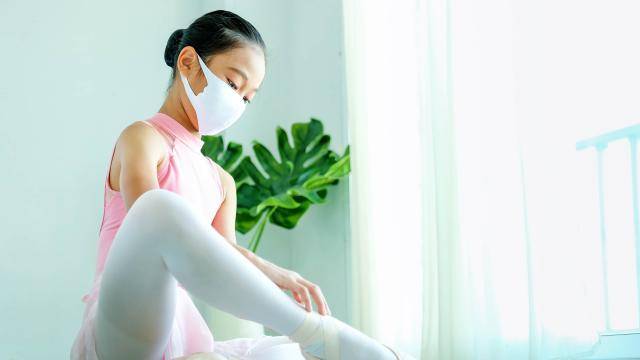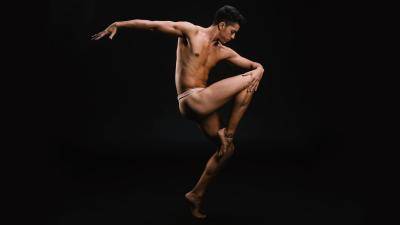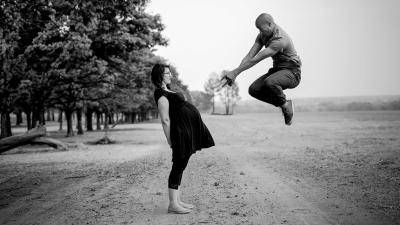As face-to-face dance training is beginning to resume around the United States, many decisions have been made, or are in process, regarding best safety practices. On my social media accounts, I've seen multiple videos of dance studios with neatly taped out perimeters in which students are doing their best to stay within the lines. Various bottles of hand sanitizer line the walls of the room that I assume smells of the lingering odor of cleaning products. The most significant and striking addition to me is the face masks that I've seen dancers wearing. The CDC currently recommends the wearing of a cloth face covering when six feet of social distancing cannot be maintained. Dance USA offers recommendations on the use of face coverings in the dance studio. These include monitoring for breathing issues related to the mask, such as lightheadedness, dizziness, and shortness of breath. Doctors For Dancers suggests triple-layer cloth face coverings that don’t get sucked into your mouth or touch your tongue when breathing. They do not encourage dancing in N-95 masks, saving those for our medical professionals. Additionally, the filters on N-95 masks, or similar styles, only filter the air you breathe but not the air you exhale. This means that the mask is offering no protection to those around you.
Finding a face covering that fits your face well means you may have to try out a few before finding the perfect match. This may be the cute floral face mask your aunt sewed for you, or one of the new fancy dancer or athlete-specific breathable face masks on the market, such as Bloch's or Under Armour's. Dance USA also states that "masks should fit snugly over the nose and mouth, not be touched once placed on the face, and washed or discarded immediately after each use." Since wearing a face-covering in the studio is most likely in your future, let's chat a little about dancing or teaching while wearing one.
Here's your learning opportunity - use the mask as a literal shield to hide behind to try using your face more.
Considerations for Dancers
The first, and I think the most crucial, consideration is that some say wearing a mask can decrease airflow, or make one feel as though breathing is more labored. As dancers, we are often trained to push through and keep going even if we're in pain or not feeling at our best. We must listen to our bodies and acknowledge when a break might be needed. While moving, we also may notice our bodies feeling warmer due to the extra layer of fabric on our face and breathing warm air into the face mask. Additionally, as we step back into the dance studio, our cardio respiratory fitness and dance training may be behind what it was before shelter-in-place orders, which makes monitoring our breathing and heart rate even more paramount. Parents and teachers (see below) should also keep watch on those under 18 years of age.
In my life, I regularly try to find a positive learning opportunity in most situations. Though not always successful, I think there are a few promising lessons to be explored. First, those who struggle with facial expressions shouldn't be getting any corrections about your lack of smile anytime soon. So here's your learning opportunity - use the mask as a literal shield to hide behind to try using your face more. Gleaning cues from the prompts of your teacher, the feelings you infer from the music or lyrics, and the style of movement, allow your face to respond and react. For those to whom using their face while dancing doesn’t come naturally, expression requires training your face muscles through repetition just like the other skeletal muscles in our bodies. Before you know it, you might find doing so enjoyable! And speaking of the body, just like athletic tape or a brace can bring more internal awareness to an injured body part, your face covering might just be the tangible reminder needed to activate your facial expressions. Further, Tyra Banks would like to remind you that your eyes are visible, so smizing is an available choice when the opportunity arises.
With mask wear, we must consider that many of our students glean non-verbal communication from the teacher’s face.
Considerations for Teachers
As a teacher, I urge you to reflect upon the safety precautions mentioned above for yourself but also as you plan your classes. The length and intensity of combinations should be scaled accordingly, accounting for the students’ age group. Consider providing more rest breaks by dancing in smaller groups and movement check-ins that ask your students to focus on how they feel. By creating gestures for symptoms like dizziness and shortness of breath, the students can both do the movement and focus on their sensations, creating greater body awareness.
As the teacher, you should also be wearing a mask. The previously mentioned Doctors For Dancers lecture cited a study that found that yelling instructions and counts could cause particulate matter to spread eight to ten feet. With mask wear, we must also consider that many of our students glean non-verbal communication from the teacher’s face. A smile can help that constructive critique land much more smoothly than a frown. With mouths and noses being covered, those non-verbal cues might be missed. How you use your vocal inflection as well as language choices may need some alteration. And, if you were (are) one of those who rehearsed facial expressions in every mirror you pass by, consider doing the same with your new face-covering so you can see what your students see. There are also transparent face masks and reusable make-at-home options that might be beneficial for those teaching younger students. Let's teach with love, compassion, and empathy, as so many of us are facing battles unlike ever before.
Ultimately, the effects of mask use during exercise are still being studied and will take some experimentation by all who wear them. Wearing a mask does not offer 100% protection so it’s also important to maintain social distancing and to avoid partner work, contact improvisation, and high fives after awesome dancing. And for some who have asthma or other medical diagnoses, wearing a plastic face shield may be the better option. I encourage you to follow the rules provided by your studio or school for the safety of us all and to find a way to have some fun and find the positives while wearing the hottest new accessory.




